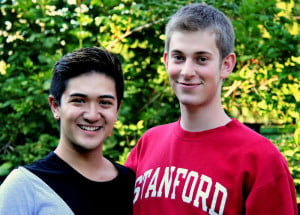Jason Galisatus ’15 is the founder of the LGBT anti-bullying group Bay Area Youth Summit (BAYS) and– as one of 12 nominees entered for online voting this year– potentially the youngest Individual Community Grand Marshal in the history of San Francisco’s Gay Pride Parade (SF Pride). BAYS has also been chosen as a candidate for Local Organizational Grand Marshal, while Galisatus was recently selected as The Bay Area Reporter’s Best LGBT Youth Activist under age 25 for his work with BAYS. The Daily sat down with Galisatus to discuss BAYS and his hopes for this year’s SF Pride.

The Stanford Daily (TSD): First of all, congratulations on your nomination! How does the voting process work?
Jason Galisatus (JG): So basically, the organization accepts nominations by email, so both my organization and I had been nominated by the public, and now the voting goes back to the public for people to cast their votes.
TSD: What is the mission of your organization, BAYS?
JG: It’s a really fun endeavor and something that really allows me [to] pursue social justice by empowering fellow LGBT youth to combat bullying. We host an annual conference every year, so the next one is coming up on May 11 at Aragon High School in San Mateo [where Galisatus attended school]. We will be featuring the keynote speakers Zach Wahls, who spoke at the Democratic National Convention on behalf of the Obama campaign, as well as the writer of “Milk”– Oscar-winning screenwriter Dustin Lance Black– and then a number of other really great people.
Our main goal is to really make LGBT youth an empowered group within society. I think that the youth in the LGBT community have a lot to offer, and I would like for my organization to be an impetus to engage youth within society and within the political process. When youth are empowered, that does a lot for combating bullying. They feel compelled to stand up to bullies in their school and reject intolerance, which I think is the ultimate goal of our organization.
TSD: How did you found BAYS?
JG: During my sophomore year of high school, I brought together all the school GSAs [Gay Straight Alliance clubs] in my school district to sort of share ideas and collaborate and see how we could pool resources. Once we gathered the group together, we decided we wanted to expand this to put on a full conference, and so we had our first one on April 23, 2011 at Aragon High School. We had about 200 attendees, and we wanted to continue to do it, but after that, we decided to expand the organization and file for 501c3 status, which is a nonprofit incorporation for the IRS.
TSD: Besides your annual conference, how else is BAYS involved with the LGBT youth community?
JG: Aside from putting on this big conference, we are working on putting together something called the Middle School Safety Initiative, which is actually a program that is currently in research and development. We’re working with a research group down in Palo Alto to get some more information on how LGBT students in middle school are being treated and how we can best meet their needs.
And from that research, we are going to develop an anti-bullying curriculum that high school students can give to middle school students in the classroom. It’s a really good program that not only teaches middle school students how to be more accepting to others, but also for high school students to really make a difference in their communities.
TSD: So now let’s talk about SF Pride. Have you ever been involved with the parade before?
JG: I’ve never been involved with the organization, and I’m not currently involved with the organization, but in the past my organization has marched within the parade, and I used to work for former mayors Gavin Newsom and Ed Lee as an LGBT Community Liaison in high school, so I’ve planned their contingents. I’ve done a lot of work in Pride, but I’ve never actually worked with Pride itself.
TSD: What happens if you’re selected as SF Pride’s Grand Marshal?
JG: If I win Grand Marshal, then I’ll have my own contingent and they give you a car and you get to headline the parade. So if I win, I’ll be in it, and even if I don’t win, I’m sure that my organization will be participating anyway.
TSD: How stiff is your competition?
JG: The other people who have gotten nominated are some pretty fantastic members of the community. Marlena is one of them, and she owned the longest running drag show in the United States that recently closed– she’s a community hero. As well as Marlena, a number of other community leaders and business owners are up for selection. In terms of organizations, we’re up against a lot of fantastic groups that cover a broad range of issues within the LGBT community, everything from H.I.V. and AIDS to funding LBGT projects that further equality. We have some fantastic contenders, so we’ll see what happens, but either way it’s an honor to be nominated.
TSD: What is the significance of SF Pride in your eyes?
JG: The first Gay Pride Parade happened a year after the Stonewall Riots. The riots occurred in New York City in 1969 when the police raided a gay bar, and the people rioted against the police and resisted arrest. So the parade started annually after that to commemorate these brave community members. In my opinion, Pride is a celebration of LGBT heritage. I think the community has really been shrouded by stigma and by oppression, and so it’s really [a] statement of our identity.
